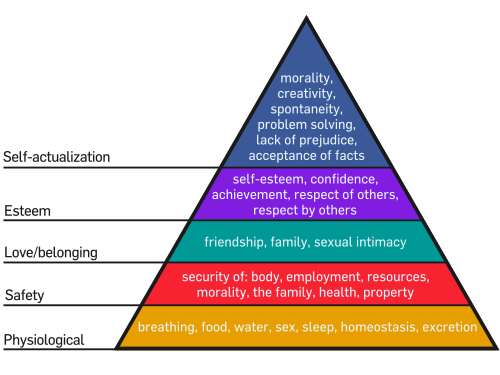I've been focusing on different themes than usual with regard to
my company and I've come to realize it might just be a mental shift on the Maslow pyramid.
We are still a tiny company (just 4 people) and our business isn't large in terms of income, but I think it's probably enough for me to trigger a shift into my thoughts.
Maslow's hierarchy of needs describes the stages in human growth and it seems to apply just as well to a company:
 Physiological needs
Physiological needs
The lowest level in the Maslow pyramid are the physiological needs. These are the basic survival needs: air, water, food, shelter and sex.
There is nothing fancy here. A company at this stage is basically aiming for that ramen profitability. Everything else are mostly nice thoughts, because the immediate future is all about corporate survival.
When I first started my company, this was the most important thing. I didn't care about anything else, except knowing that I had customers and I was profitable. Of course, personally I've been lucky to have some nice and decent customers where I worked on some interesting stuff, but from a corporate standpoint it was all about being profitable and having projects to keep me, and later my team, busy and liquid.
Safety needs
Wikipedia has a nice explanation:
These needs have to do with people's yearning for a predictable orderly world in which perceived unfairness and inconsistency are under control, the familiar frequent and the unfamiliar rare.
This is where I find myself to be since about last summer...
Ever since the financial crisis came in Romania too, the government has made a lot of unexpected and rash changes: laws changed over night, tax legislation changed, corporate expenses limited by law in weird ways.
Also, corruption was left basically unchecked, while the government still found enough time to waste money.
So, I've started yearning for some
predictable legislation (fiscal, labour, etc) as well as a reduced threat of corruption.
I still haven't found a solution to this. Since changing Romania first is impractical, I've been reading a lot about incorporating into other countries.
This is a complicated equation involving corporate specific variables such as taxation, accounting expenses, rent as well as personal variables: I'd probably need to relocate or travel a whole lot more and that's hard.
Love and belonging
Love and belonging has two levels in a company: internal and external.
Internally I don't think we have a particularly strong belonging feeling since we were very focused on just getting the job done. We are distributed in 3 cities quite far away so there is no physical closeness which I think hinders us a bit.
This is something we should work at, but I guess it's not on the list yet. One of my future plans is maybe get an actual corporate office but that's a problem in itself and it would split us: 2 guys would work in an office and 2 guys 500km away.
Externally, the company sends upstream bugfixes for the open-source code we work on, we support the localization effort into Romanian of an open-source product and this year I want to get a junior researcher / student into a part-time position doing open research (it's basically a sponsorship disguised as a job since legally it's way simpler).
But, sadly, the company isn't involved at all in the local community.
Esteem
Esteem means wanting respect, status, fame and attention as well as self-respect, competence, mastery, self-confidence, independence and freedom.
So far the company is very low level and mostly "behind the scenes". We basically do contract work so the end users never know anything about our involvement.
It would be nice to be known by our users and even nicer to be independent and actually sell products to end users directly. But we are not there yet.
Self-actualization
"What a man can be, he must be." Realizing the full potential.
I'm not even sure what to speculate here. I believe we have something interesting and I'm rather proud of my team but I couldn't say exactly what the full potential is. Still searching this one.
Conclusions
Maslaw's pyramid seems to be a quite nice simplification. Of course, the layers intertwine and evolution isn't linear like that but it seems to apply quite nicely for a startup too (which isn't entirely surprising since a company is a social construct.)
It might be an interesting exercise to analyze your own startup through this hierarchy and see where do you stand as well as what you should be focusing on.
